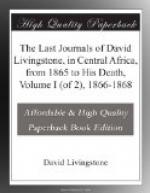The rains are expected here when the Pleiades appear in the east soon after sunset; they go by the same name here as further south—Lemila or the “hoeings.”
In the route along the Rovuma, we pass among people who are so well supplied with white calico by the slave-trade from Kilwa, that it is quite a drug in the market: we cannot get food for it. If we held on westwards we should cross several rivers flowing into the Rovuma from the southward, as the Zandulo, the Sanjenze, the Lochiringo, and then, in going round the north end of Nyassa, we should pass among the Nindi, who now inhabit the parts vacated by the Mazitu, and imitate them in having shields and in marauding. An Arab party went into their country, and got out again only by paying a whole bale of calico; it would not be wise in me to venture there at present, but if we return this way we may; meanwhile we shall push on to Mataka, who is only a few days off from the middle of the Lake, and has abundance of provisions.
26th June, 1866.—My last mule died. In coming along in the morning we were loudly accosted by a well-dressed woman who had just had a very heavy slave-taming stick put on her neck; she called in such an authoritative tone to us to witness the flagrant injustice of which she was the victim that all the men stood still and went to hear the case. She was a near relative of Chirikaloma, and was going up the river to her husband, when the old man (at whose house she was now a prisoner) caught her, took her servant away from her, and kept her in the degraded state we saw. The withes with which she was bound were green and sappy. The old man said in justification that she was running away from Chirikaloma, and he would be offended with him if he did not secure her.
I asked the officious old gentleman in a friendly tone what he expected to receive from Chirikaloma, and he said, “Nothing.” Several slaver-looking fellows came about, and I felt sure that the woman had been seized in order to sell her to them, so I gave the captor a cloth to pay to Chirikaloma if he were offended, and told him to say that I, feeling ashamed to see one of his relatives in a slave-stick, had released her, and would, take her on to her husband.
She is evidently a lady among them, having many fine beads and some strung on elephant’s hair: she has a good deal of spirit too, for on being liberated she went into the old man’s house and took her basket and calabash. A virago of a wife shut the door and tried to prevent her, as well as to cut off the beads from her person, but she resisted like a good one, and my men thrust the door open and let her out, but minus her slave. The other wife—for old officious had two—joined her sister in a furious tirade of abuse, the elder holding her sides in regular fishwife fashion till I burst into a laugh, in which the younger wife joined. I explained to the different headmen in front of this village what I had done, and sent messages to Chirikaloma explanatory of my friendly deed to his relative, so that no misconstruction should be put on my act.




